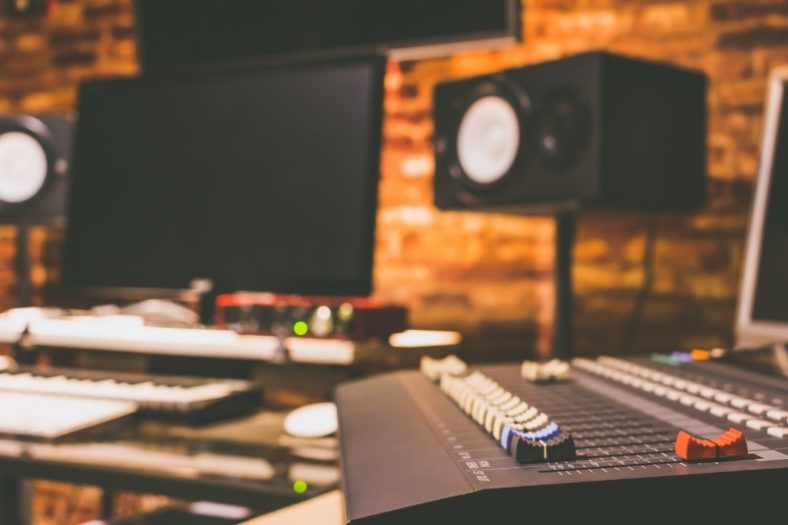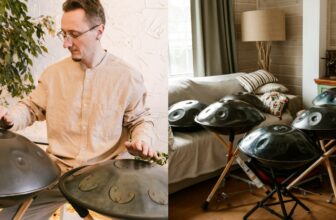How to Make Ambient Music (9 Tips)
Ambient music is a type of music that focuses on textures and soundscapes rather than melodies and beats. It’s usually characterized for having a soothing, relaxing effect and for its loose structure, lack of identifiable motifs and chord progressions, and high dependence on abstract noises and atmospheres.
While some ambient music is purely acoustic, the genre is most commonly associated with electronic music. Virtual and analog synthesizers, effects, and digital audio workstations (DAWs) make for the most useful equipment for creating ambient music. If sufficiently processed, traditional instruments such as electric guitar, violin, and piano can also play an important compositional role.
Producing ambient music looks easy… Until you try it! Because coming up with a good-sounding ambient track can be a challenge, I compiled nine useful tips for creating ambient music. These are mostly oriented to electronic producers with access to a DAW, but they can be helpful to all types of composers.
Contents
- 1. Start With a Drone
- 2. Use Reverb and Delay
- 3. Turn Off the Metronome
- 4. Get Inspired by Field Recordings
- 5. Sound-stretching is Your Best Friend
- 6. Combine Sounds With Volume Automation
- 7. When Processing Sounds, Hit ‘Record’
- 8. Avoid Chords That Create an Expectation
- 9. If it Doesn’t Sound Good, Reverse it
- Summary
1. Start With a Drone
In music, a drone is a monophonic effect in which a single note or chord is sustained for a long period. Since ambient is a genre that relies heavily on atmospheres, drones can be the perfect starting point for any uninspired ambient producer. To make a drone, simply select a note and timber you like and record it for a long time.
Drones are an amazing starting point for an ambient track for two reasons. On the one hand, they allow you to quickly create a soundscape with a strong tonal center that will make it a lot easier to add new sounds to the arrangement.
On the other, they’re a great way of ensuring your ambient track will stay on point. One of the biggest challenges of creating ambient music is resisting the temptation of adding rhythmic patterns and melodic motifs that will make an ambient song sound like… Well, something that’s not an ambient song!
In the end, you can always remove the drone you used to start your ambient track if it’s no longer pivotal to the arrangement.
2. Use Reverb and Delay
This is probably the most obvious tip to make the list, but it’s a must-have nonetheless. If there’s a music genre that depends heavily on effects such as reverb and delay, that’s ambient music.
Reverb and delay help you to automatically generate long, dense sounds that have an ambient-y feel to them. A patch as simple as an acoustic piano can be the perfect engine to an ambient track if it’s processed with enough reverb. Similarly, a heavily-delayed guitar can have the same effect.
All reverb and delay effects will work wonderfully in the context of an ambient track, adding a much-needed sense of space and depth. However, some VSTs are more helpful than others. I would recommend the entire Eventide Audio reverb bundle as an ideal ambient-oriented, unique-sounding piece of software.
Ableton Live’s stock Echo plugin is also very good, especially once you start tweaking its ‘Character’ functions, such as Wobble, Noise, and Ducking.
3. Turn Off the Metronome
Understanding ambient music structure (or the lack of it) is one of the main challenges associated with the genre. If you’re an electronic music producer who’s accustomed to making beat-oriented tracks, you’ll probably find it hard to transition to a genre as abstract and spatial as ambient. Luckily, there’s an easy way to ensure that your ambient songs will never feel too loopy or rhythmic.
Ambient music should be about going with the flow and getting lost within the sounds. To get in the right mindset for creating atmospheric sounds, I’d recommend turning off the metronome. Listening to a steady 4/4 beat while creating an ambient track is a certified way of making it sound too stale and repetitive.
If you want to make good-sound ambient songs, a fixed tempo can be your worst enemy. Ambient music should be like water: it should flow freely and without constraints.
4. Get Inspired by Field Recordings
If you have ever stopped to smell the roses, you may have realized that there’s no real silence in nature. Coincidentally, the natural world is filled with inspiring sounds for ambient-music creators. If you’re lacking that special bit of inspiration, collecting a few field recordings can be a great way to make your creativity flow.
Having a high-quality Zoom recorder that you can take with you to the woods or the beach is the best way to come up with some decent field recordings, but you can use something as simple as your phone’s microphone if you have to, and still get excellent results!
At its best, ambient music attempts to recreate a natural space in which sounds move freely and away from crippling musical notions such as meter, tonality, and structure. Is there a better way to make your ambient songs sound like nature than by sampling nature itself?
5. Sound-stretching is Your Best Friend
Ambient music is usually long and slow. So it’s no wonder that many ambient producers rely on stretched samples to create the basis for their ambient tracks. Stretching samples is a great way of automatically generating interesting sounds that can cover a lot of ground, all while having an unexpected and random feel to them.
Ableton Live users can luckily rely on the DAW’s excellent Warping algorithms, which include modes such as ‘Complex’ and ‘Texture,’ perfect for this type of sound. All you have to do to convincingly stretch a sample is drag a .wav file into the program and make it as long as possible. This will cause the track to be warped into a slow-morphing soundscape that will instantly sound like an ambient atmosphere. You can even drag full commercially-released songs to the DAW, as they will be radically different once processed.
For a more peculiar tip, take a look at Paul’s Extreme Sound Stretch audio-stretching program. Don’t be fooled by its “90s-Internet” look: this handy piece of free software is capable of stretching any sound source into ridiculous lengths, all while maintaining very good sound quality. It’s a must-have gem for every ambient producer out there.
6. Combine Sounds With Volume Automation
Volume automation is essential to producers regardless of genre, but it plays a particularly important role in ambient music production. While some ambient tracks are largely based on one unique, super-long texture, others are made out of an intricate combination of sounds that morph into one another. If you want your ambient tracks to sound like the latter, you should make the most of volume automation.
Pad sounds make for perfect patches for ambient-music creation because they’re very soothing, but also because they tend to have a very long attack and release. Attack and release are an understated type of volume automation, and that may help to explain why they fit so seamlessly into an ambient-music arrangement.
A long attack (i.e., a volume fade-in) has got to be the easiest, best way to introduce a new sound to an ambient song. On the other hand, a long release (i.e., a volume fade-out) is a great way to create transitions between different textures within an ambient track.
7. When Processing Sounds, Hit ‘Record’
Ambient music producers will spend a lot of their time tweaking effects and working on sounds. It’s only natural: while genres like rock and techno rely heavily on pre-established timbres such as the sound of a distorted electric guitar or a deep electronic kick, ambient is all about creating unique-sounding textures.
But here’s an idea: while you’re tweaking a texture with a bunch of reverb, delays, and saturation, try to hit ‘record.’ In the end, you’ll have a long .wav file with many nuances in sound that can be extremely useful to spice up your ambient arrangement. Sure, this quasi-random recording will not always work, but keep in mind you can always transform it into something entirely new.
One of my favorite things to do in Ableton Live is recording an Operator patch to a separate track while I’m working on it. This way, I have an interesting-sounding .wav file that didn’t take any of my time and that can be worked into something new. I love to make long processing files very short with Ableton Live’s warping algorithms to create frantic sounds or transpose the .wav file up to 48 semitones to make for a buzzy, bee-like atmosphere.
8. Avoid Chords That Create an Expectation
Ambient music is all about texture. But that doesn’t mean that ambient has to be an a-musical genre. While some top-quality ambient tracks sound like the inside of a cave, others make use of actual music theory notions to develop interesting chord progressions and subtle melodies that have a soothing effect.
If you plan on using chords in your ambient tracks, make sure you’re avoiding chords that create a high sense of expectation. The last thing you want in an ambient song is musical tension and chords that are begging to go somewhere. For this reason, I’d recommend you to stay away from dominant chords and V chords, and build your song’s harmonic motion on top of more neutral intervals such as fourths and octaves.
If you feel like you need to have a V on your ambient track, try to invert the voices to attenuate the feeling of expectation generated by these chords. First-inversion V chords will sound a lot smoother and a lot less urgent.
9. If it Doesn’t Sound Good, Reverse it
Whether you’re using a reverse pedal or relying on a reverse VST, the ability to reverse sounds should be a part of every ambient producer’s musical arsenal.
Reversed sounds work great within an ambient song for two reasons. On the one hand, they have a characteristically ambient-y texture, which is even more convincing once you add a bit of reverb and delay—once again, the long fade-ins that are naturally generated when a track is reversed work in your favor.
On the other hand, reversing sounds is perfect for recycling short melodic phrases that could be on your ambient track if they sounded less musical. If you want to include a melodic sample with a beautiful timbre in your arrangement, but it is just not sitting right, reversing it is probably the answer. By reversing a short melodic phrase, you get to maintain its sound-texture properties without objectively using the melody in your ambient track.
Summary
I’ve already briefly mentioned that ambient music is inherently about discovering and exploring nuances in sounds. And while many producers achieve this by tweaking their VSTs’ parameters, I find it much more interesting to use randomization. By following the tips I’ve shared with you today, you’ll be able to write some great-sounding ambient tracks that are unique and interesting.






